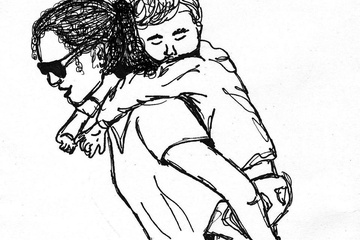As a student in Adams House, Becky A. Cooper ’10 hand-printed blank maps of Manhattan at Bow and Arrow Press. In the summer of 2009, Cooper walked down Broadway handing them out to strangers and asking them to “map their memories” and mail the finished product back to her. The resulting project, labeled a “PostSecret-style tribute to Manhattan,” features maps filled in by post-docs, senior citizens, and a handful of celebrity New Yorkers, among many others. A former Crimson Arts editor, Cooper compiled these maps into her first book “Mapping Manhattan: A Love (And Sometimes Hate) Story in Maps by 75 New Yorkers,”which was published this April. She is currently expanding the project to Harvard Square.
Fifteen Minutes: How did you come up with the idea for the project?
Becky Cooper: I was accidentally hired the summer after my freshman year to make a map of all the public art in Manhattan. Because I had basically no graphic design experience and definitely no cartography experience, I was hyper-aware of the decisions I was making and of questions like whether a carousel is art, or whether the art in public schools or hospitals is public. [My boss’s] goal was to create a thorough map of Manhattan. She wanted it to have 1,500 pieces of artwork and cross-references to the artwork’s provenance on the back, along with a thumbnail image of each. But no matter how much we were printing on this map, it was never going to be thorough. It was necessarily going to be a subjective, filtered view of Manhattan and of public art in general.That realization came in concert with seeing these napkins pile up next to my desk of where I was heading on a given night. It was before I had a smartphone, so I would draw myself these little maps. I realized that those maps, in series, told an interesting story about my life that summer. They told an interesting story of the city. In some ways, it was a more honest story than the one I was building [for my boss] because it was celebrating the subjectivity of the mapmaker. Those two realizations, coupled with my having read Italo Calvino’s “Invisible Cities” the year before, grew into this: I wanted to give really small, limited maps to as many New Yorkers as possible and have them map their New Yorks. And then, in series, have a New York emerge from there.
FM: How do you see the relationship between maps and memory differing between Cambridge and New York?
BC: In Cambridge, you have really different populations. You have the students whose relationship to the area is acute but ephemeral, but you also have the Cambridge personalities who are so much of what this city is. [For students] you get a lot of introspection, and you get it focused in a really small area. [For example,] memory is ascribed to particular rooms in buildings.The way that I went about doing Cambridge differently was that I had a lot of anonymous students do it, but I also reached out specifically to business owners. Because I think more than in New York, their businesses, or their personalities, or their names are part of what makes Cambridge what it is. And having them identified added a layer of understanding to Harvard Square. Like the shoe repair guy: What is his Cambridge? Or the guy in the comic store, what’s his? Or the almost- banned bookseller?
FM: In your book, you included your own map of Manhattan. In Harvard Square, where would you begin?
BC: I think my map would necessarily be a love story. I haven’t drawn it yet, but what’s interesting about these maps is that what you initially think you’re going to draw is not what you end up drawing. I think I would draw Bow Street and Arrow Street as the cupid bow that they form, and then put in particular spots where my flashes of memory are really vivid, and then the walks in between them. Obviously the Bow and Arrow Press is where I printed the maps, and I lived in Adams House. But also, I love that there’s this romance built into the geography of the area, and I think that thematically plays well with the spirit of the project.


